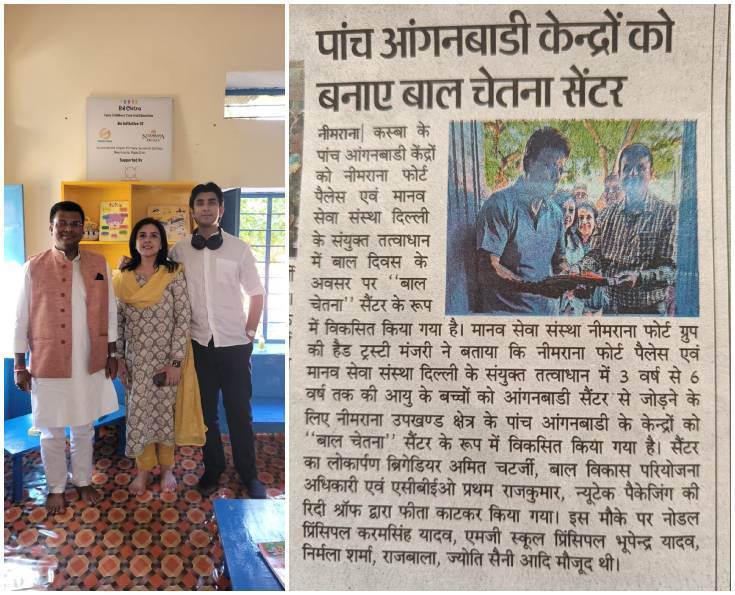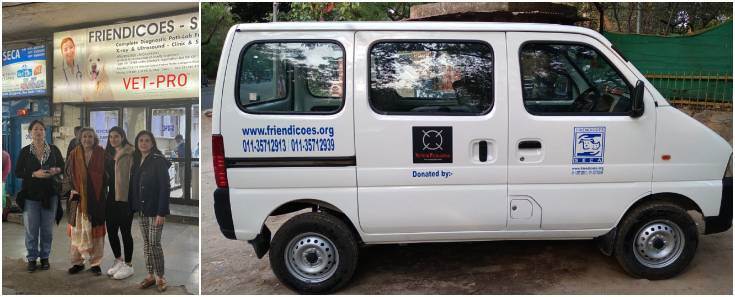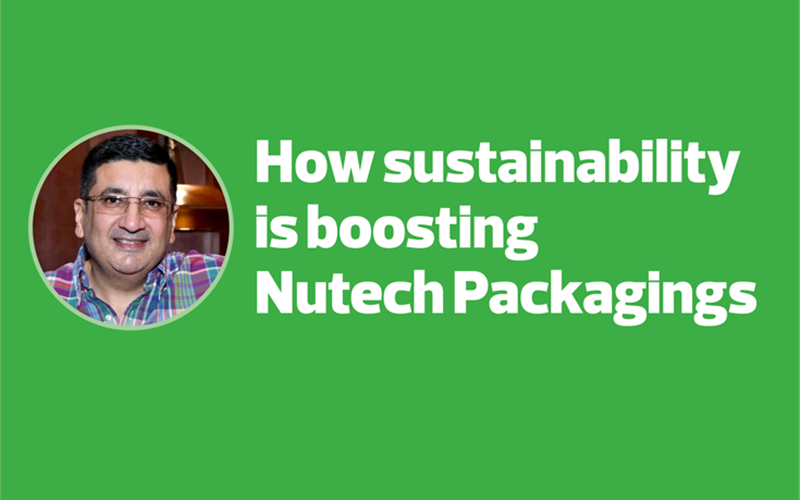How sustainability is boosting Nutech Packagings - The Noel D'Cunha Sunday Column
Since embarking on his green journey in 2014, Nutech Packagings’ managing director Jatinder Shroff has added sustainability and CSR to its programme. Nutech's green building in 2018 was an important milestone. In this Sunday Column, Shroff highlights the importance of green as a strategy to boost bottomline.
02 Jul 2023 | By Noel D'Cunha
Green often refers to environmental concerns and sustainability, but its significance extends beyond being an ecological imperative or social responsibility causes. But for Jatinder Shroff, managing director at Nutech Packagings, sustainability and environmental protection do not mean just that. “It is my vision to contribute in whatever way possible to create a better environment for future generations. Marketing benefits and future trading are byproducts that will help us.”
While sustainably producing print needs to start with the company being green, which makes sustainable print manufacturing plant key. It is said, look at the various sustainability certifications available. These provide a solid framework to guide your thinking and pointers for making environmental improvements.
In 2014, Shroff planned his building specially constructed to meet his business requirements. He chose an Indian Green Building Council (IGBC) certification. “It was important for us to start the project on a note where we could build a more eco-friendly building,” says Shroff.
The Indian Green Building Council (IGBC) is a part of the Confederation of Indian Industry (CII), formed in 2001. The council's vision is, ‘to enable a sustainable built environment for all and facilitate India to be one of the global leaders in the sustainable built environment by 2025.’
IGBC has over 8,660 registered green projects with a footprint of over 9.75-billion sqft, of which 500+ are green factories, making India second in terms of green footprint.
Sustainability – a long-term vision
Sustainability is a long-term vision and requires an untiring commitment by an organisation.

According to experts, green buildings are defined as structures that ensure efficient use of natural resources like building materials, water, energy and other resources with minimal generation of non-degradable waste.
Nutech undertook this initiative by adopting building materials and technologies that consume less energy and are not harmful to the environment compared to constructing a conventional building.
It is worth considering what the competitors and other types of businesses are doing on the green initiatives. It becomes easy to find information on programmes that a lot of organisations sign up to. Of course, companies like Tetra Pak and Huhtamaki and EPL are driving change in our industry and take inspiration from them.
Shroff says, when he started the project, there were very few companies moving in this direction. “But it was our own initiative, and we worked towards it.” He adds, “I have always been interested in the conservation of the environment, so from the initial stages, we involved a green building consultant along with the architect to discuss the various facets of a green building and implement them.”
While it is a good idea to engage with expert, independent third parties, to develop an honest and comprehensive sustainability audit, Shroff's starting point was keeping regular checks on various aspects in order to achieve the certification. “Our consultants were doing it for us.”
In its endeavour, Shroff says, the Indian Green Building Council (IGBC) was very supportive, guided us through their recommendations, and enabled us to achieve a green factory rating. Nutech received its IGBC certification rating in 2018.
“We used sustainable and passive design features, for instance, adequate daylighting. This feature includes using simulation modelling to achieve preferred lux level for efficiency as compared to a conventional building,” says Shroff. Using
competent materials like AAC blocks in the wall, double-glazed glasses, and low VOC paints, plus thermal mass and insulations, such as high SRI paint and AAC wall with low u-value, became a norm.
In addition, water saving is another feature. “We have achieved it by using low-flow fixtures, an efficient irrigation system and 100% rainwater harvesting, and recycling wastewater through Sewage Treatment Plant (STP). Using an efficient metering system, we also monitor water and energy at various locations. We have also installed the Effluent Treatment Plant (ETP) as per requirement. Further, the plant is equipped with energy-efficient equipment and appliances, such as an HVAC system with high COP, LED lighting (for interior and outdoor), CFC-free fire fighting systems, pumps and motors,” explains Shroff.
Best practices and benefits
We asked Shroff what are the three best practices he follows. First, he says the use of adequate daylight and ventilation in built spaces. “Second, using water-saving plumbing fixtures and treating wastewater through STP and effluents by ETP. Third, use of energy-efficient equipment and appliances compared to the conventional building.”
Switching to green has positives. The potential for savings is even more critical. The cost of energy is increasing, and the demand is becoming insatiable.
Using sunlight during the daytime and LED can save an enormous amount of energy. Further, the use of proficient plumbing fixtures along with wastewater treatment plants helps in saving a lot of water and makes a building self-sufficient to a large extent. Even energy suppliers will match some or all of the electricity you use with renewable energy. Shroff is in the process of deploying the use of solar panels to provide the building with energy, which will be accomplished by the end of the financial year. “In the first phase, we estimate that they will provide us with 50% of our energy requirements,” informs Shroff.
Since the IGBC project was initiated, all new machines Nutech procured are carbon neutral. “We use more environmentally friendly chemicals and consumables wherever possible. We also use FSC-certified material wherever possible.”
And procuring green-certified products and materials isn’t difficult, says Shroff. “The IGBC provides a list of various green-certified materials and vendor details. One can procure green building materials by contacting them.”
So, why is green buildings not becoming a norm in the print industry if it’s such a beneficial business strategy? “It should have, and it’s not very difficult,” says Shroff.

He explains how to do it. “Incorporate passive design strategies such as the orientation of the building, shape and size of the building and designing according to the climatic zone of India. Then planning spaces and designing them according to universal standards, for example, designing workspaces for differently-abled as per norms. Lastly, providing indoor and outdoor breakout spaces for workers for relaxation, providing healthy food, and water and ensuring safety along with organising regular health checkups for workers, and maintaining indoor air quality for better work efficiency.”
Finally, Shroff says, it’s very important to train your team. “Our green building consultant, along with our project team, played a vital role in educating our workforce by conducting various workshops on the use of eco-friendly material and safety,” says Shroff.
The IGBC building certificate is one of Shroff's many initiatives. “We always look for avenues to improve our efforts in this direction if they are viable. We are FSC certified and use FSC-certified materials wherever possible. We are planning to go in for a GreenCo certification and working towards it,” says Shroff, adding, “We are in the process of making a new office which will be an IGBC-certified green office.”
So which is the best system for an MSME factory in a country like India? “For a start, I believe ISO-14001 is a good certification,” concludes Shroff.
Nutech Packagings’ Green Practices
-
IGBC-certified green building
-
An effluent treatment plant (ETP) and a sewage treatment plant (STP), the treated water is used for gardening and flushing purposes.
-
All plants in the garden have been specifically chosen as they use the least amounts of water to grow.
-
Standard green practices such as rainwater harvesting pits and composting.
-
The new office, also in the middle of being built, will be built according to green office specifications.
-
Use solar panels to generate electricity as per needs is work-in-progress.
-
All the new machines are carbon neutral.
-
Regular disposal of electronic waste safely and through the proper organizations/channels.
Nutech’s CSR programmes
Nutech Packagings, through the NGO Manav Sewa Sansthan, has generously sponsored rations for a duration of one year, benefiting 50 elderly and destitute individuals. Additionally, Nutech Packagings has extended its support by sponsoring medication for blood pressure and diabetes and physiotherapy sessions for one year, benefiting 50 individuals in need.

Nutech Packagings has also taken the initiative to sponsor two Aanganwadi centres. One is in Sanskriti School, Peepli Village, and the other in Mahatma Gandhi School, Neemrana Village. These centres have been beautifully adorned with colourful images and furnished with educational toys, tables, mats, chairs, and a TV for enhanced learning experiences. Academic books have been provided to the students, promoting knowledge and literacy. Additionally, Nutech Packagings has played a vital role by printing and donating the teachers' training manual for the schools, contributing to their educational development.
In an extraordinary display of compassion and dedication, Nutech Packagings joined forces with the esteemed NGO Friendicoes to address the pressing needs of stray animals. Through our collaborative efforts, we nourished 1,200 dogs and 70 cats, ensuring they received the sustenance required for their well-being. Additionally, our partnership extended to the crucial sterilisation task, with Friendicoes leading the way in sterilizing 200 stray dogs. We have also donated an EECO Van to Friendicoes, which is used as an Ambulance and to rescue stray animals. Together, we made significant strides in alleviating the suffering of these vulnerable creatures and promoting a more sustainable future for both animals and humans.













 See All
See All